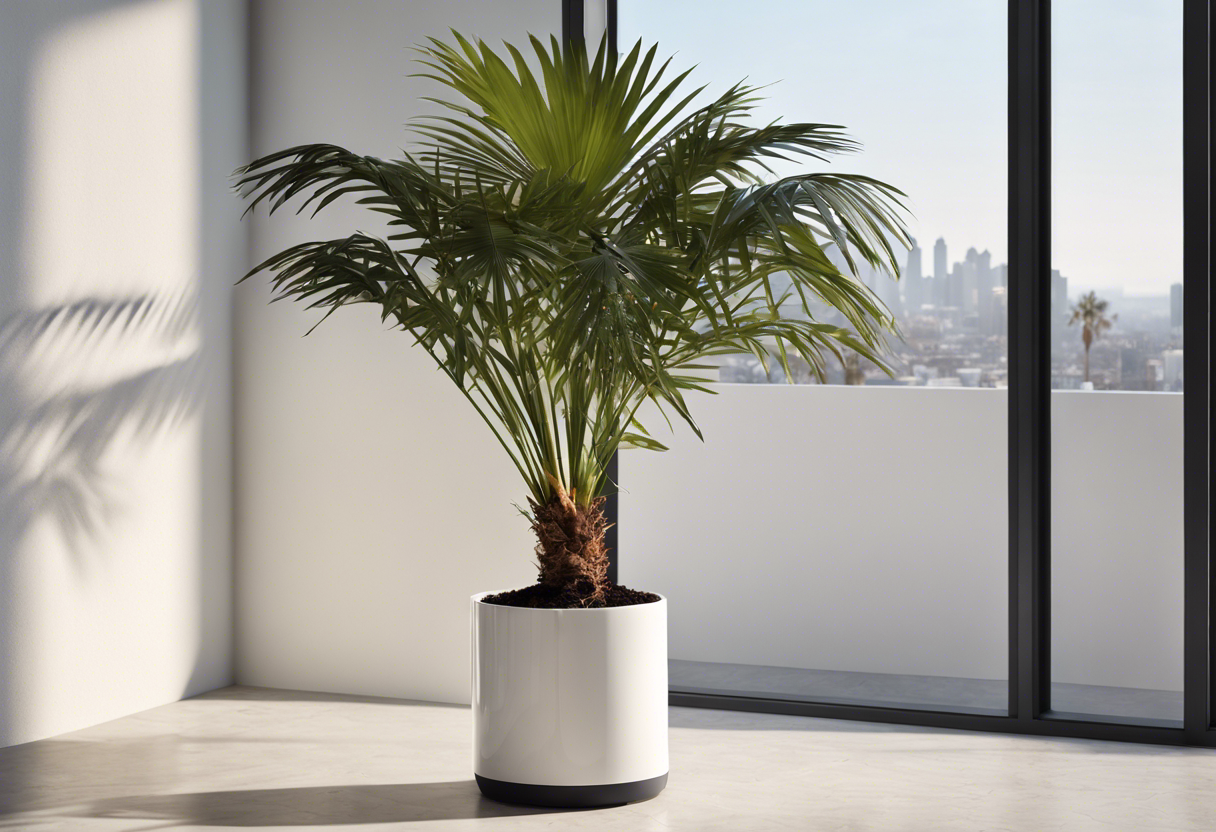Ever had that moment when you look at your once thriving indoor palm tree and realize it’s just a shadow of its former glory? You’re not alone, mate! I’ve been there, staring at my drooping palm wondering How to Revive a Dying Indoor Palm Tree.
But fear not, fellow green thumbs! This guide is here to help you nurse your leafy buddy back to health. Keep reading about how to revive a dying indoor palm tree and soon enough, you’ll be basking in its tropical splendor again.
Key Takeaways
- Identify the problem with your indoor palm tree by checking for signs like yellow leaves, brown leaf tips, or slow growth.
- Overwatering and underwatering are common issues; adjust watering based on the plant’s needs.
- Provide adequate light but avoid direct sunlight which can scorch the leaves.
- Maintain a consistent temperature and humidity level suitable for palm trees.
- Use a well-draining soil mix and fertilize sparingly.
- Prune dead or dying fronds to promote new growth.
Understanding the Problem
When it comes to How to Revive a Dying Indoor Palm Tree, knowing what’s wrong is half the battle. It’s like being a plant detective, sifting through clues and symptoms. We’ll be focusing on two key areas: signs of decline and common causes.
Identifying Signs of a Dying Indoor Palm Tree
So, how do you know if your indoor palm tree is throwing in the towel? Well, there are some telltale signs. First off, if you notice yellowing palm leaves, that’s not a good sign. It’s like your palm tree is waving a yellow flag of surrender.
Another red (or should I say brown?) flag is brown leaf tips in palms. If the tips of your palm leaves look like they’ve been dipped in chocolate, it’s not because they’re trying to be fancy. It’s a cry for help!
Lastly, keep an eye out for wilting. If your once proud and erect palm starts slumping over like it can’t bear its own weight, well… that’s another sign of a wilting indoor palms problem.
Common Causes for Indoor Palm Tree Decline
Now that we know what to look for let’s talk about why this might be happening. One common culprit is overwatering. Yes, you heard right! Your love and care might actually be drowning your beloved palm! Overzealous watering can lead to soggy roots and ultimately an overwatering indoor palms issue.
Another common cause could be lack of sunlight. Palms are sun-loving creatures by nature so if yours isn’t getting enough rays, it could start feeling under the weather – hence leading to an insufficient light for palms situation.
Finally, poor soil conditions could also be at play here. Just like us humans need nutritious food to thrive, plants need good quality soil! So, if your palm is stuck in subpar soil, it might start showing signs of a poor soil conditions for palms problem.
Assessing Your Indoor Palm Tree’s Health
When it comes to how to revive a dying indoor palm tree, understanding your plant’s health is key. It’s like being a plant detective, where you’ll be investigating soil condition, watering practices, and signs of pests or diseases. This is the cornerstone of indoor palm tree health and essential for effective indoor plant care.
Checking the Soil Condition
First off, let’s talk about the dirt. The soil condition plays a huge role in your palm’s well-being. You see, palms are pretty picky about their environment. They need well-draining soil that’s not too soggy or too dry.
To check the palm tree soil condition, simply stick your finger about an inch into the soil. If it feels dry, it might be time for a drink. But if it feels wet or soggy, you might be overdoing it with the H2O.
Remember folks, maintaining good indoor palm soil quality is crucial for its survival. So don’t neglect this step!
Evaluating Watering Practices
Speaking of water, let’s dive into watering practices next. Overwatering is like kryptonite for these green beauties – they just can’t handle too much love!
Proper watering indoor palms involves giving them a good soak then letting them dry out before watering again. This prevents root rot and other nasty issues caused by overwatering.
So remember folks, when it comes to palm tree watering practices, less is often more! Keep an eye out for signs of overwatering like yellow leaves or droopy fronds.
Inspecting for Pests and Diseases
Lastly but definitely not leastly (is that even a word?), we have pests and diseases – every plant parent’s worst nightmare!
Common culprits include spider mites, mealybugs, and scale. These little buggers can cause a whole lot of damage if left unchecked.
To inspect for palm tree pests or diseases in indoor palms, check the underside of leaves and look for any discoloration or spots. If you notice anything unusual, it might be time to bring out the big guns (aka pest control).
So there you have it folks! Remember, when it comes to how to revive a dying indoor palm tree, prevention is better than cure. So keep an eye on your plant’s health and take action at the first sign of trouble!
Reviving Techniques for a Dying Indoor Palm Tree
So, you’re looking to learn how to revive a dying indoor palm tree? Well, you’ve come to the right place! We’ll be diving into some top-notch techniques that will turn your palm from drab to fab.
Adjusting Watering Techniques
First things first, let’s talk about water. Your palm is like a diva – it needs just the right amount of attention. Too much or too little water can lead to problems. Signs of an overwatered palm tree can include yellow leaves and root rot. On the flip side, if your palm is underwatered, you might notice dry, brown tips on the leaves.
The key here is balance. You need to find that sweet spot in your palm tree watering schedule where your tree is neither thirsty nor drowning. A good rule of thumb (or should I say green thumb?) is to let the top soil dry out before watering again.
Modifying Light Conditions
Next up on our list of revival techniques: light conditions. Just like Goldilocks and her porridge, palms want their light “just right”. Too much direct sunlight can scorch their leaves while too little light can stunt their growth.
Different types of palms have different indoor palm light requirements, so do some research on what your specific type needs. But generally speaking, bright but indirect light works best for most indoor palms.
Changing Soil or Repotting
Finally, we come to soil and repotting – two factors often overlooked in indoor palm tree care. If your palm isn’t thriving despite proper watering and lighting conditions, it might be time for a change of scenery…or rather soil!
Palms prefer well-draining soil that’s rich in organic matter. So if you’ve been using regular old potting soil, it might be time to upgrade to the best soil for indoor palms. And if your palm has outgrown its pot or the soil has become depleted of nutrients, repotting might be just what the doctor (or should I say botanist?) ordered!
Preventive Measures to Keep Your Palm Healthy
When it comes to how to revive a dying indoor palm tree, prevention is always better than cure, mate. Let’s talk about some indoor palm care and palm tree maintenance tips that can keep your green buddy healthy.
Regular Feeding and Fertilizing
Feeding and fertilizing your indoor palm isn’t just about keeping it alive; it’s about helping it thrive. You see, palms are like us – they need good food to stay fit. So, using a proper palm tree fertilizer is key.
But don’t just grab any old plant food off the shelf. Look for a fertilizer specifically designed for palms. These usually contain the right mix of nutrients that your palm needs to grow strong and healthy.
Remember, overfeeding is as bad as underfeeding. Stick to a regular palm tree feeding schedule and your palm will thank you with lush, green fronds.
Ensuring Proper Drainage
Now let’s talk water – but not too much of it! Proper drainage is crucial in preventing root rot and other nasty diseases. Yes, you heard me right – even plants can get sick!
The trick here is balance. Your palm needs enough water to stay hydrated but not so much that its roots become waterlogged. A pot with good drainage holes can help prevent this problem.
So next time you’re watering your indoor palm, remember: less is more! This little tip could be the difference between a thriving plant and one that’s on its last legs.
Maintaining Ideal Temperature and Humidity Levels
Last but definitely not least, we have temperature and humidity control. Palms are tropical plants by nature, so they love warm temperatures and high humidity levels.
However, most homes aren’t exactly tropical paradises (unless you live in Hawaii or something). So how do we create these ideal conditions for our indoor palms?
Well, it’s all about location, location, location. Keep your palm in a warm spot but away from direct sunlight which can scorch its leaves. And to increase humidity levels, try placing a tray of water near the plant or misting it regularly.
Remember, every palm is unique and may have slightly different needs. But with these healthy palm tree tips, you’re well on your way to becoming an expert in indoor plant preventive measures and palm tree health.
To Wrap Up
In a nutshell, reviving your indoor palm tree is like nursing a hangover after a wild party – it needs time, care, and the right conditions. With the tips from our How to Revive a Dying Indoor Palm Tree guide, your plant can bounce back stronger than ever.
So don’t throw in the towel just yet! Your palm tree might be down, but with some TLC, it’s not out for the count.





